Sabes ¿Qué tan rápido puedes ir en una tabla de remo ? La mayoría de los practicantes de remo recreativos suelen ir a velocidades de alrededor de 3 a 4 nudos, lo que equivale aproximadamente a 4 millas por hora. Pero recuerda, tu velocidad de la tabla de remo Puede variar dependiendo de varios factores.
Dominar la velocidad en una tabla de remo es algo más que fuerza física. Requiere delicadeza y técnica, transformando tus paladas en propulsión eficiente. Esta guía profundiza en 8 técnicas esenciales de SUP sobre cómo ir rápido en una tabla de remo . Ya sea que navegues sin esfuerzo por aguas tranquilas o apuntes a una ventaja competitiva, estas estrategias te ayudarán a navegar con mayor velocidad y control, optimizando tu experiencia de remo. Así que, toma tu remo, súbete a bordo y prepárate para elevar tu deslizamiento.
8 consejos sobre cómo ir rápido en una tabla de remo
¿Deseas velocidad en tu tabla de remo? Domina la eficiencia con estos 8 consejos respaldados por expertos sobre cómo ir rápido en una tabla de remo en cada palada.
1. Amplíe su alcance
Olvídate de los golpes rápidos y entrecortados. Imagina que tu pala es una extensión de tu brazo, que traza un arco largo y suave a través del agua. Inicia la palada extendiendo la mano superior hacia adelante, casi tocando la punta de la tabla. Esto extiende la longitud de la palada y te impulsa más lejos con cada tirón.
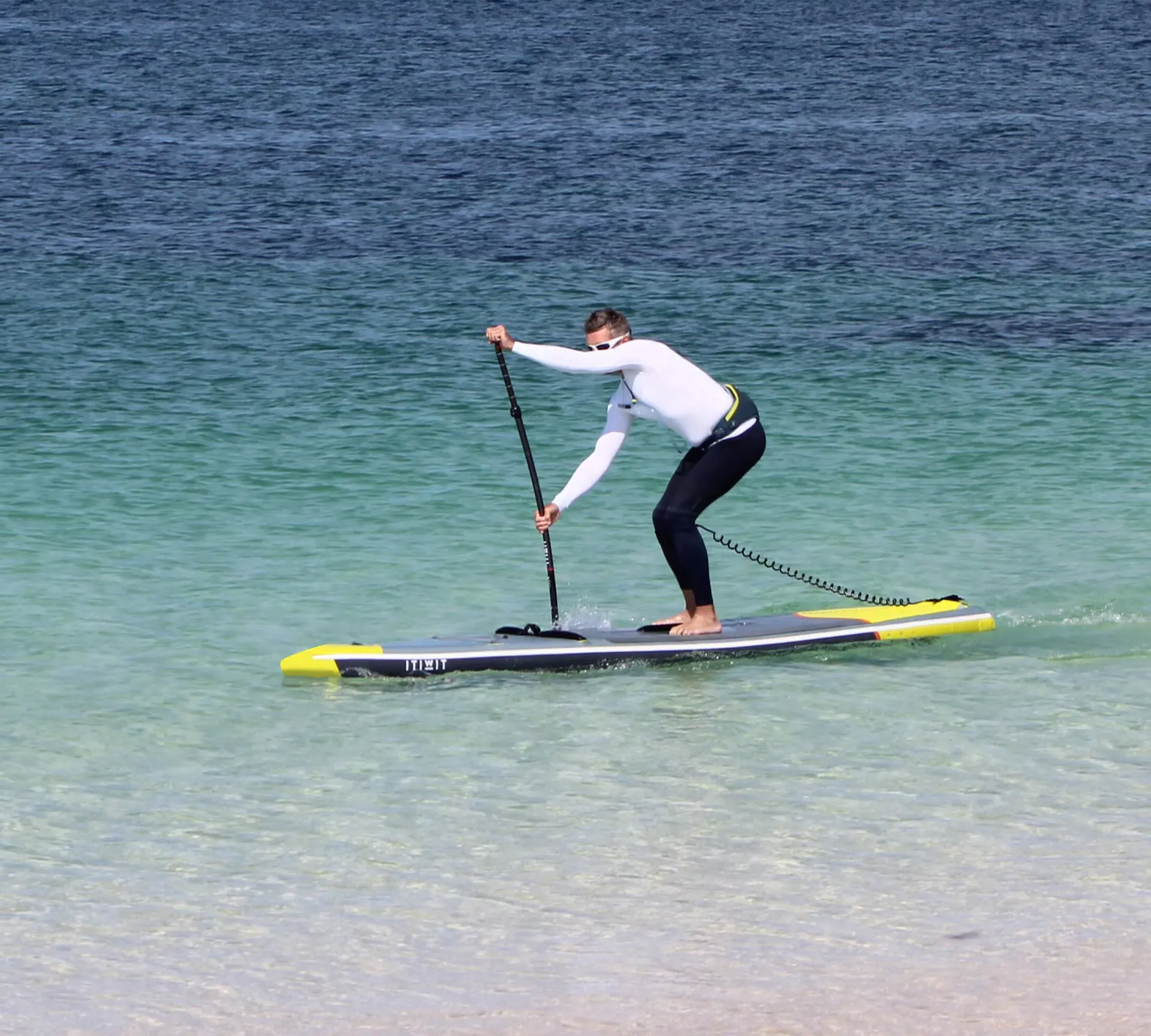
Recuerde que lo fundamental es la eficiencia, no la fuerza bruta. Concéntrese en maximizar la distancia de la pala en el agua, no en la fuerza con la que la empuja. Este movimiento fluido conservará energía y lo impulsará más lejos, lo que hará que su experiencia de remar sea más fluida y eficiente.
2. Activa tu núcleo
Aunque los brazos son los primeros en mover la pala, el secreto para una pala potente se encuentra en lo más profundo. El núcleo, no solo los bíceps, es el motor real. Activa los músculos abdominales con cada palada, iniciando el tirón desde el torso. Esto crea un movimiento estable y sinérgico, que transfiere la energía de manera eficiente desde el núcleo hasta la pala.
Imagina aprovechar todo el peso de tu cuerpo, no solo la fuerza aislada de tus brazos, para impulsarte hacia adelante. Este enfoque centrado en el core genera más potencia con menos esfuerzo, lo que hace que remar sea más suave y sostenible, a la vez que maximiza tu eficiencia en el agua.
3. Recuperación rápida de la hoja
¡No te demores! Una vez que hayas completado la maniobra y la pala salga del agua, tráela rápidamente de vuelta para la siguiente palada. Cualquier retraso innecesario en la fase de recuperación se traduce en pérdida de impulso. Intenta mantener un ritmo suave y continuo, minimizando el “tiempo muerto” entre paladas.
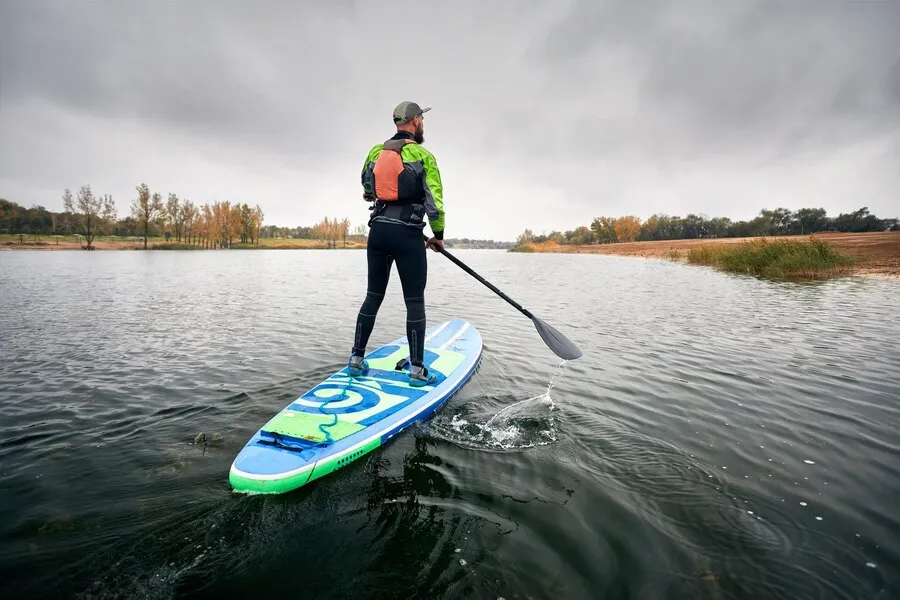
La eficiencia es la clave, y una recuperación rápida de la cuchilla garantiza que pasará menos tiempo reposicionándose y más tiempo impulsándose hacia adelante.
4. Encuentra tu punto ideal
Asegurarse de remar de manera eficiente es fundamental para aprovechar al máximo su tabla de remo. Cuando se desplaza hacia adelante en el agua, es importante no llevar el remo demasiado hacia atrás, más allá de los pies. En lugar de eso, intente introducir la pala profundamente en el agua y tirar de ella hacia atrás hasta que se alinee con sus pies. De esta manera, transfiere la mayor potencia a su movimiento. Si extiende la pala demasiado hacia atrás de sus pies, reduce su apalancamiento y lo hace más lento.
5. Terminar fuerte
Cuando saques la pala del agua, intenta no levantarla en línea recta. En lugar de eso, gira la muñeca ligeramente para que la pala quede paralela a la tabla antes de comenzar la siguiente palada. Este pequeño ajuste reduce el movimiento innecesario y la resistencia del aire, lo que facilita la transición a la siguiente palada potente con menos esfuerzo. Piensa en ello como un flujo suave y continuo de paladas en lugar de movimientos separados y desconectados. Este cambio sutil puede marcar una gran diferencia en tu rendimiento.
6. Menos es más
Si bien el instinto puede indicar que muevas los brazos con fuerza y remes con entusiasmo, recuerda que los movimientos controlados y eficientes son clave para lograr velocidad. Concéntrate en mantener tus paladas compactas y cerca de la tabla. Imagina dibujar una gran “C” con la pala de tu remo bajo el agua, maximizando la potencia generada con cada tirón.
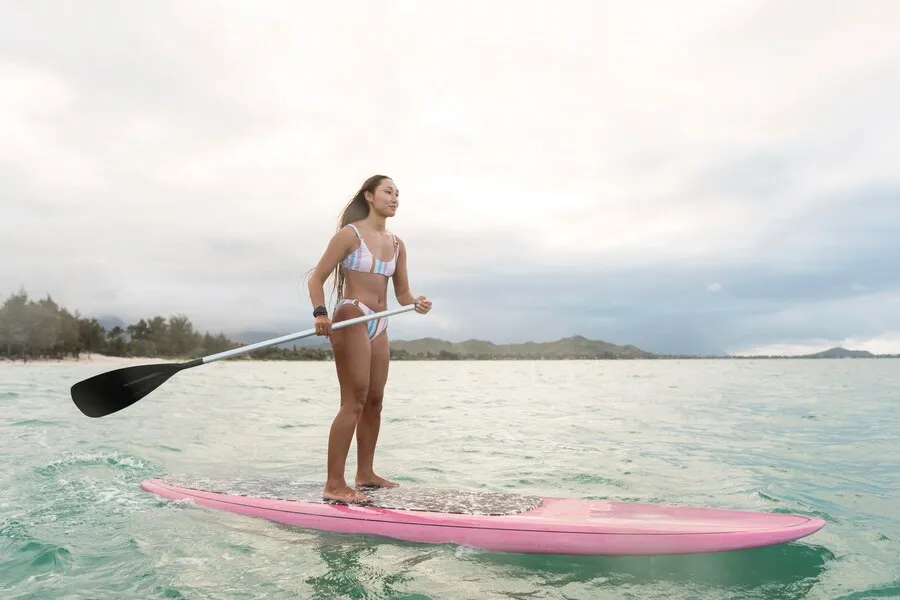
Además, evita los movimientos excesivos de los brazos o sumergir demasiado la pala en el agua, ya que esto crea una resistencia innecesaria y te hace más lento. Si te concentras en paladas controladas y deliberadas, te sorprenderá lo rápido que puedes impulsarte hacia adelante con menos esfuerzo.
7. Fuerza de los dedos del pie
El stand-up paddle boarding no es solo un ejercicio para los brazos, es una experiencia para todo el cuerpo. Activa los músculos del torso para aprovechar tu potencia e impulsarte hacia adelante de manera eficiente. Imagina estar de pie sobre las puntas de los pies, activando las pantorrillas y el torso para crear una base estable y sólida. Este ligero cambio de postura transfiere la potencia del torso a la palada, generando más empuje con cada tirón.
8. Recto y firme
Si bien la necesidad de explorar calas escondidas y deambular por canales pintorescos es vital, la línea recta es ahora la forma más eficiente de alcanzar la velocidad. Al remar en línea recta, minimizas la resistencia y maximizas la distancia recorrida con cada brazada.
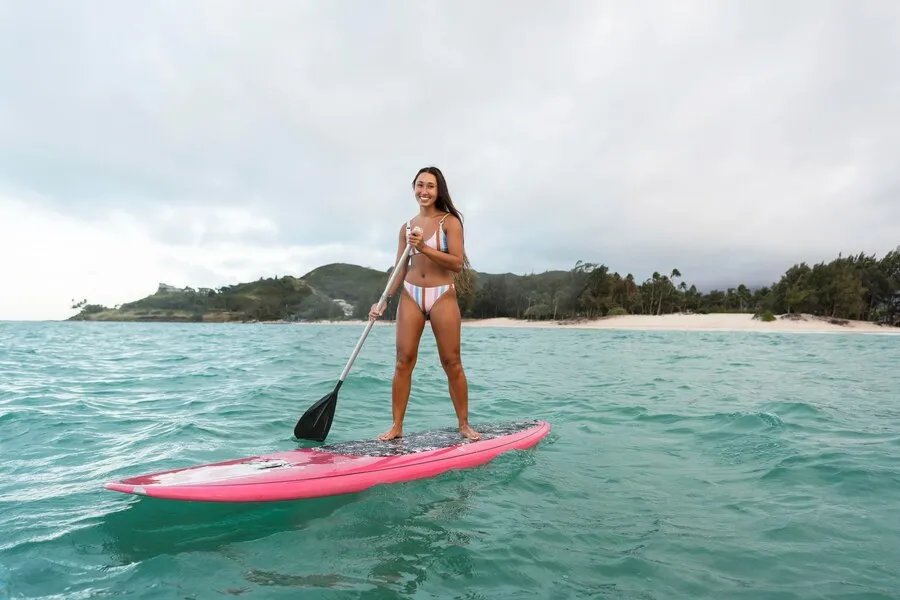
Por supuesto, siempre hay lugar para desvíos lúdicos y exploraciones espontáneas, pero priorice un rumbo recto y constante cuando busque pura velocidad. Imagínese dibujando una línea recta a lo largo de la superficie del agua y deje que esa visualización guíe sus paladas.
7 factores que afectan la velocidad de tu paddle surf
Además de reconocer “cómo ir rápido en una tabla de remo”, exploremos estos factores y descubramos cómo optimizar tu deslizamiento.
1. Tabla de surf de remo hinchable o rígida
Las tablas de SUP sólidas, con su construcción rígida, generalmente se destacan en este ámbito. Sus formas aerodinámicas y cascos más rígidos experimentan menos resistencia y flexión, lo que se traduce en deslizamientos más rápidos y una remada más eficiente. Esto las hace ideales para remeros de competición, de turismo y experimentados que buscan una velocidad óptima.
Sin embargo, las tablas de surf de remo inflables han avanzado mucho. Los diseños avanzados y la tecnología de costura en zigzag ofrecen una mayor rigidez, y algunas tablas de travesía inflables pueden competir con sus contrapartes sólidas en condiciones tranquilas. Sus perfiles más anchos y cascos más gruesos a menudo crean más resistencia, lo que limita sus velocidades máximas.
2. Forma y diseño de la tabla de remo
Para los aficionados al remo, la velocidad puede ser un aspecto emocionante del deporte. Pero ¿sabías que el diseño de tu tabla influye significativamente en la velocidad con la que te deslizas por el agua? Comprender estas características clave te permitirá elegir la tabla perfecta para tu necesidad de velocidad.
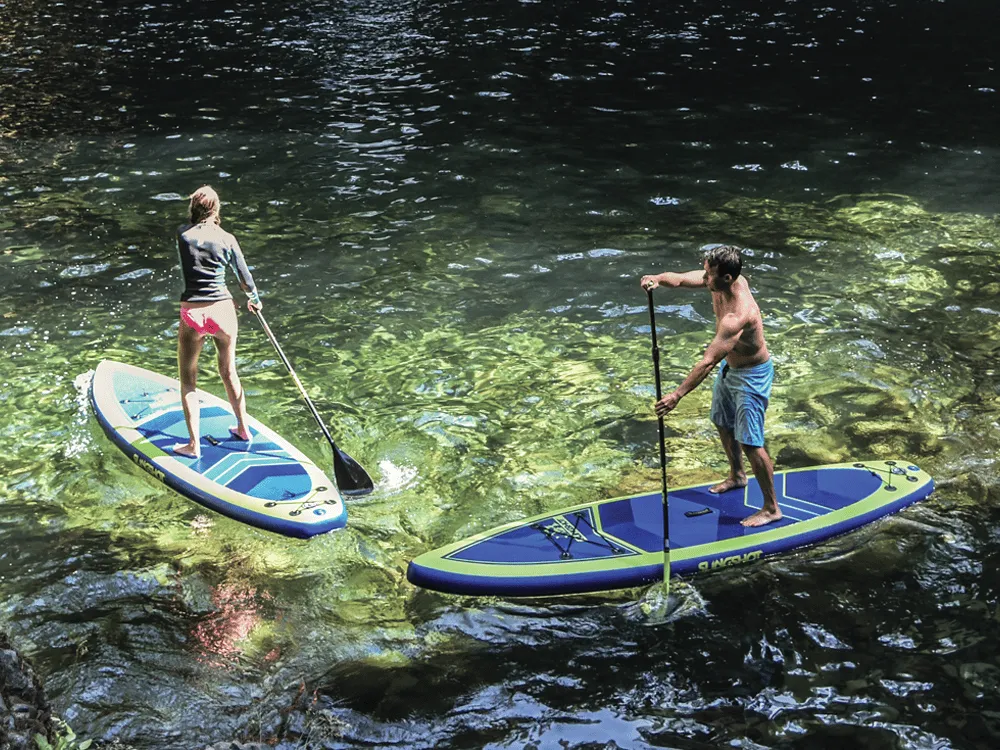
Un factor crucial es la forma del casco. Con sus puntas puntiagudas y diseños cónicos, los cascos de desplazamiento cortan el agua con una resistencia mínima, lo que convierte el esfuerzo de remar en un movimiento eficiente hacia adelante. Por el contrario, los cascos de planeo, que suelen encontrarse en tablas más anchas, se deslizan por la superficie del agua, lo que ofrece estabilidad pero sacrifica algo de velocidad.
El ancho de la tabla también influye. Las tablas más estrechas, con menos superficie en contacto con el agua, experimentan menos resistencia, lo que las hace ideales para navegar a velocidades más altas. Sin embargo, las tablas más anchas ofrecen mayor estabilidad, especialmente para principiantes o condiciones de olas agitadas.
La longitud también tiene su impacto. Con una línea de flotación más larga, las tablas más largas se deslizan sin esfuerzo y mantienen el impulso con cada palada. Esto las hace perfectas para remar o competir a larga distancia. Las tablas más cortas, si bien son menos eficientes en distancias más largas, se destacan en maniobrabilidad, lo que las hace ideales para navegar en las olas o explorar espacios reducidos.
Por último, tenga en cuenta las aletas. Las aletas de un solo centro proporcionan un excelente seguimiento, lo que garantiza que se mueva en línea recta y maximiza la velocidad. Las aletas extraíbles ofrecen versatilidad, lo que le permite cambiar diferentes configuraciones para diversas condiciones del agua.
3. Aptitud física
Un centro fuerte es la base para una remada eficiente. Proporciona estabilidad, lo que permite transferir la potencia de las piernas y el torso a la palada, maximizando su eficacia. Por el contrario, un centro débil provoca un equilibrio inestable y un desperdicio de energía.
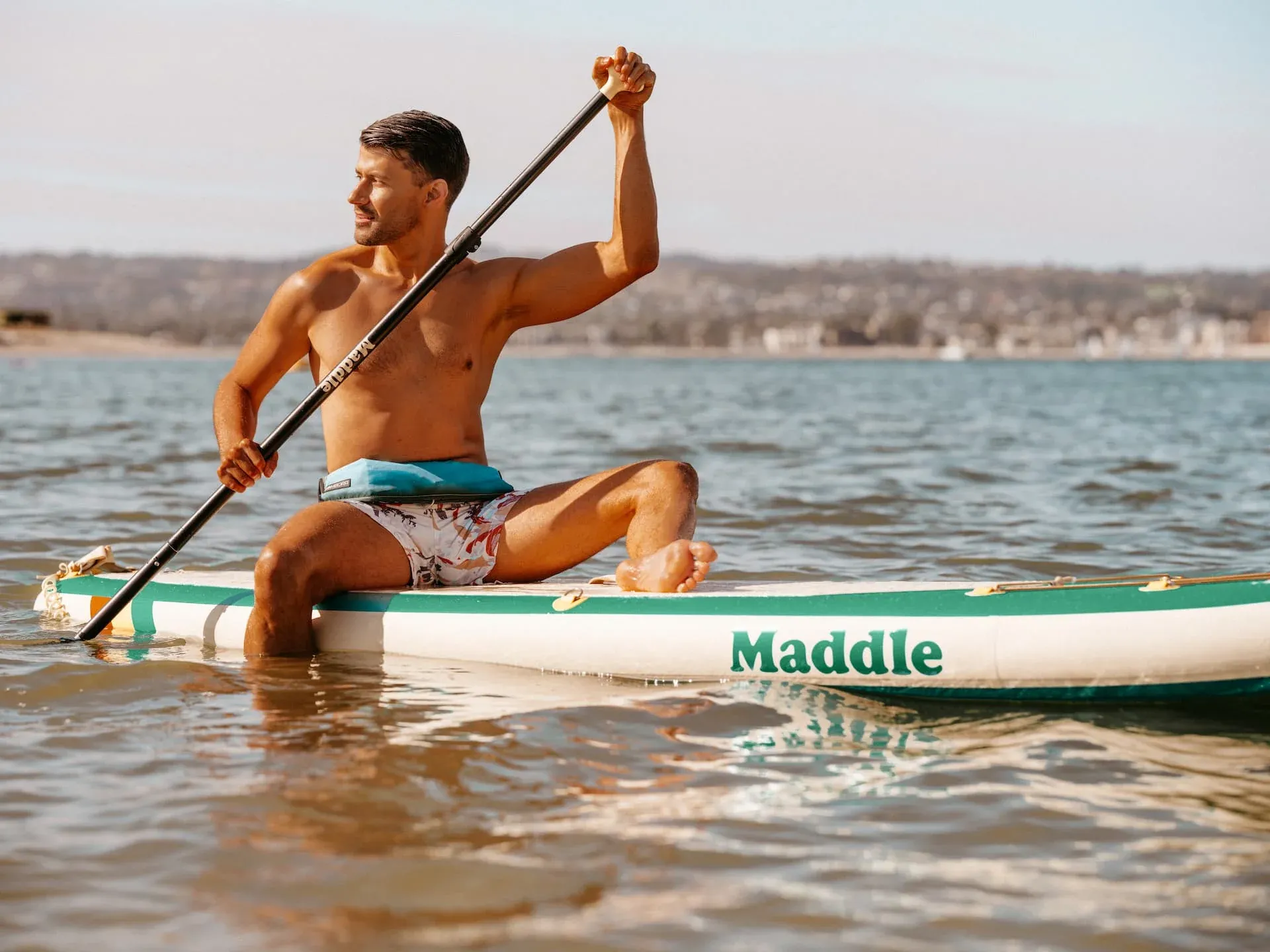
La aptitud cardiovascular es igualmente crucial. Remar exige un esfuerzo sostenido, y un corazón y unos pulmones bien acondicionados garantizan que puedas mantener un ritmo fuerte durante distancias más largas. Imagínate correr a toda velocidad por un lago en calma: una buena salud cardiovascular hace que no te resulte difícil, mientras que una mala condición física te deja sin aliento y con dificultades.
Más allá del core y el cardio, la fuerza en los brazos, la espalda y los hombros contribuye a realizar brazadas potentes. Unos brazos demasiado desarrollados sin fuerza en el core pueden provocar fatiga y lesiones.
4. Cuidado de la tabla y el remo
A pesar de que a menudo pasa desapercibido en las guías sobre cómo ir rápido en una tabla de remo , el cuidado óptimo de la tabla y del remo es crucial para maximizar tu velocidad y eficiencia. Piensa en ello como si estuvieras poniendo a punto un coche de carreras; incluso las pequeñas imperfecciones pueden afectar tu rendimiento.
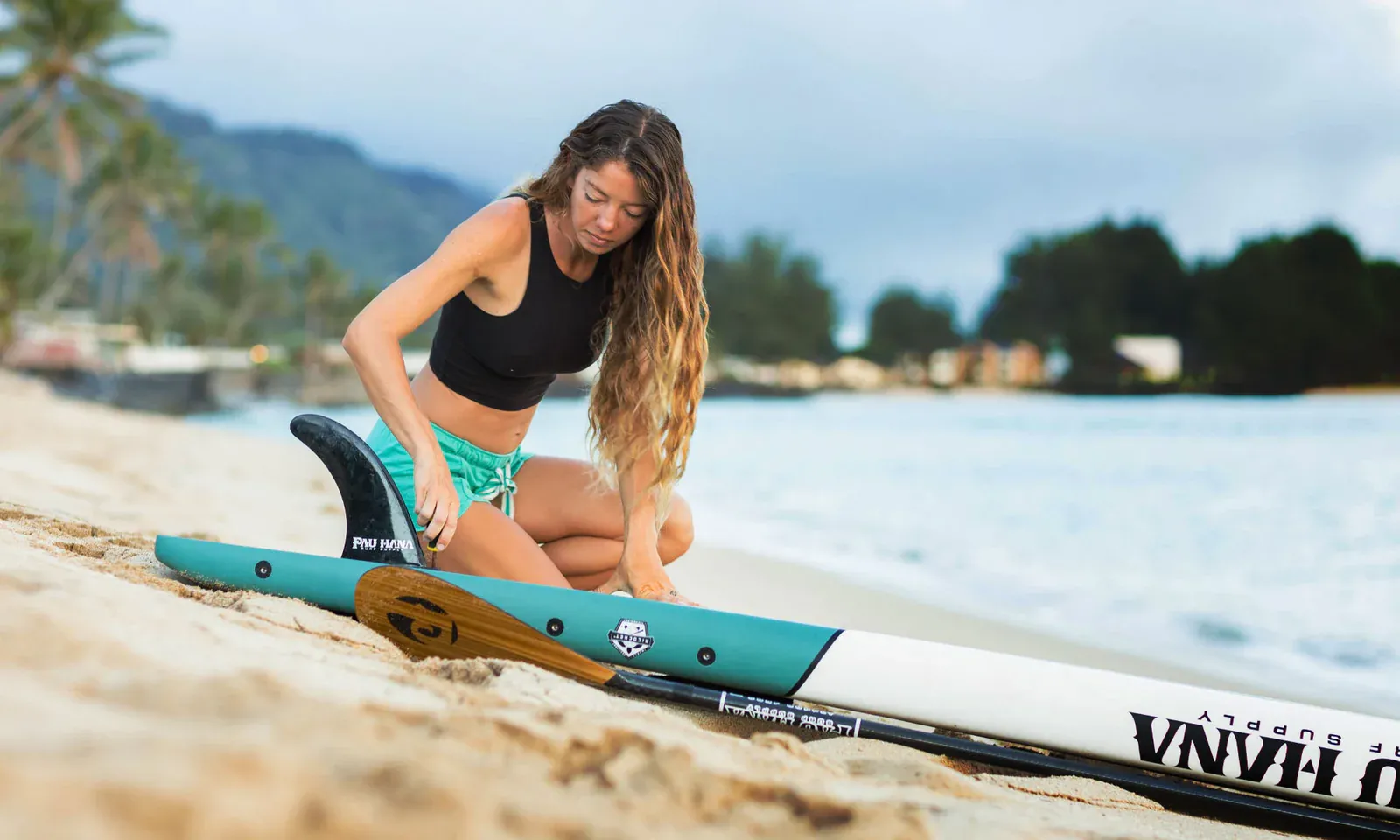
Empezando por la tabla, incluso los pequeños golpes y rasguños generan resistencia y hacen que la tabla vaya más lenta. Inspeccione regularmente la tabla para ver si tiene daños y repare de inmediato cualquier muesca o grieta. El consejo es que un casco liso se traduce en una navegación tranquila.
El cuidado de las palas es igualmente importante. La acumulación de suciedad en la pala aumenta la resistencia, mientras que las palas deformadas o dañadas afectan la transferencia de potencia. La limpieza regular y el almacenamiento adecuado garantizan un rendimiento óptimo, especialmente en el caso de las palas de fibra de carbono.
5. Condiciones climáticas y del agua
Al buscar “Cómo hacer paddle surf más rápido ”, puedes ver que las condiciones del viento y del agua juegan un papel importante en la determinación de la velocidad de tu tabla de paddle surf. Los vientos en calma y el agua plana ofrecen escenarios ideales, lo que permite paladas eficientes y un deslizamiento máximo. Específicamente, el Viento ideal para practicar paddle surf Es una brisa ligera, normalmente de menos de 10 nudos, que viene desde atrás o desde un costado. Este tipo de viento puede ayudar a su movimiento, lo que hace que sea más fácil mantener el impulso sin luchar excesivamente contra las condiciones.
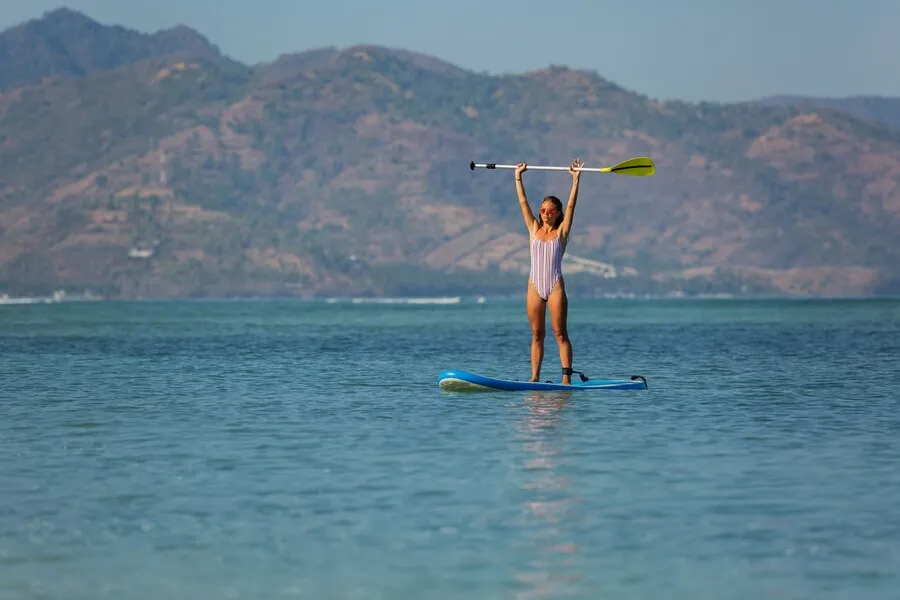
Sin embargo, la ecuación se vuelve más compleja a medida que aumenta la velocidad del viento. Los vientos de cola suaves pueden ayudarte, mientras que los fuertes vientos en contra crean resistencia y exigen un mayor esfuerzo para un progreso mínimo. Por el contrario, los vientos cruzados pueden desviarte del rumbo y requerir ajustes constantes.
Las condiciones del agua también influyen en la velocidad. El agua picada provocada por el viento o las olas altera el flujo de la tabla, lo que aumenta la resistencia y reduce el impulso. Por el contrario, el agua tranquila y plana permite un deslizamiento suave, maximizando la velocidad con cada palada.
Además, ten en cuenta las mareas y las corrientes. Remar contra una corriente fuerte será agotador, mientras que una corriente favorable puede aumentar tu velocidad sin esfuerzo.
Por lo tanto, comprender y respetar las condiciones climáticas y del agua son esenciales para optimizar su experiencia con el remo y garantizar la seguridad y el disfrute.
6. Uso eficiente de la energía
En una tabla de remo, cada brazada cuenta. Si bien la fuerza bruta puede impulsarte hacia adelante al principio, la velocidad real proviene del uso eficiente de la energía. Imagina remar con los músculos tensos, brazadas agitadas y una postura dispersa. Este enfoque caótico agota rápidamente tu energía, dejándote sin aliento y lento.
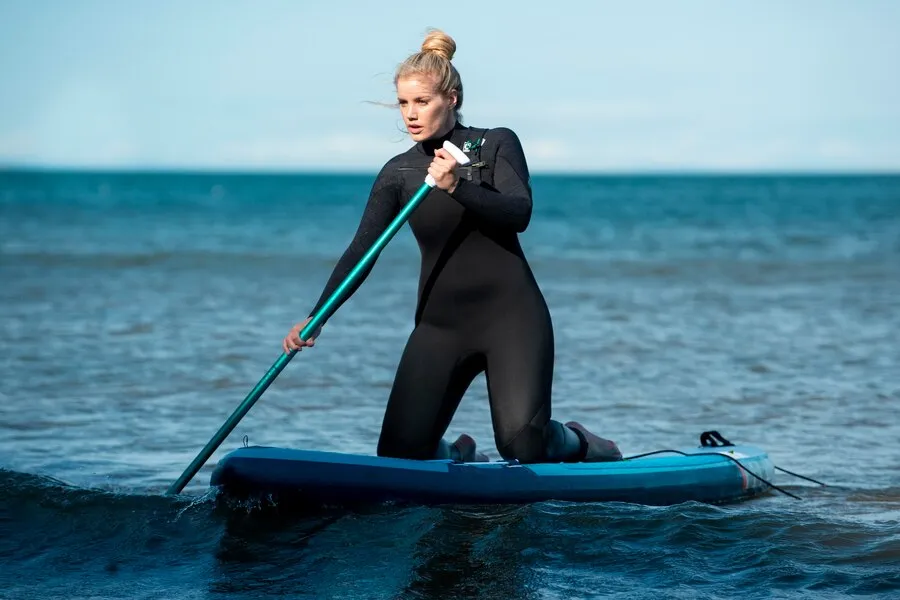
De lo contrario, un movimiento de remo suave y controlado impulsado por el centro del cuerpo involucra grupos musculares más grandes, lo que minimiza el esfuerzo desperdiciado. Esto se traduce en paladas más largas y potentes que te impulsan más lejos con cada inmersión.
Además, los remadores eficientes administran su energía de manera inteligente. Evitan los arranques frenéticos y optan por un ritmo sostenible, que se adapta al viento y las corrientes. Este enfoque mesurado conserva la energía para cuando realmente la necesitan, lo que les permite acelerar el ritmo en los sprints o navegar en condiciones difíciles.
7. Ajuste de la carga de la placa
Si bien las tablas más livianas se deslizan más rápido, un enfoque minimalista solo es ideal en ocasiones. Lograr un equilibrio entre el equipo esencial y el control del peso es crucial para optimizar la velocidad sin comprometer la seguridad ni el disfrute.
Cada libra que se añade a la tabla desplaza agua, lo que aumenta la resistencia y requiere más esfuerzo para impulsarse. Por el contrario, una tabla cargada correctamente, con el peso distribuido de manera uniforme, puede mantener la estabilidad y un seguimiento eficiente. Esta estabilidad permite paladas potentes y minimiza el desperdicio de energía por tambaleo.
¿Cómo hacer paddle surf más rápido?
Entonces, ¿cómo ir rápido en una tabla de remo? Te presentamos Boost Fin , un accesorio de aleta eléctrica liviano (2,7 lb) que puede mejorar significativamente tu velocidad y experiencia con la tabla de remo. Su potente motor de 800 W ofrece hasta 20 lb de empuje, lo que te impulsa a velocidades de 5 mph con un mínimo esfuerzo.
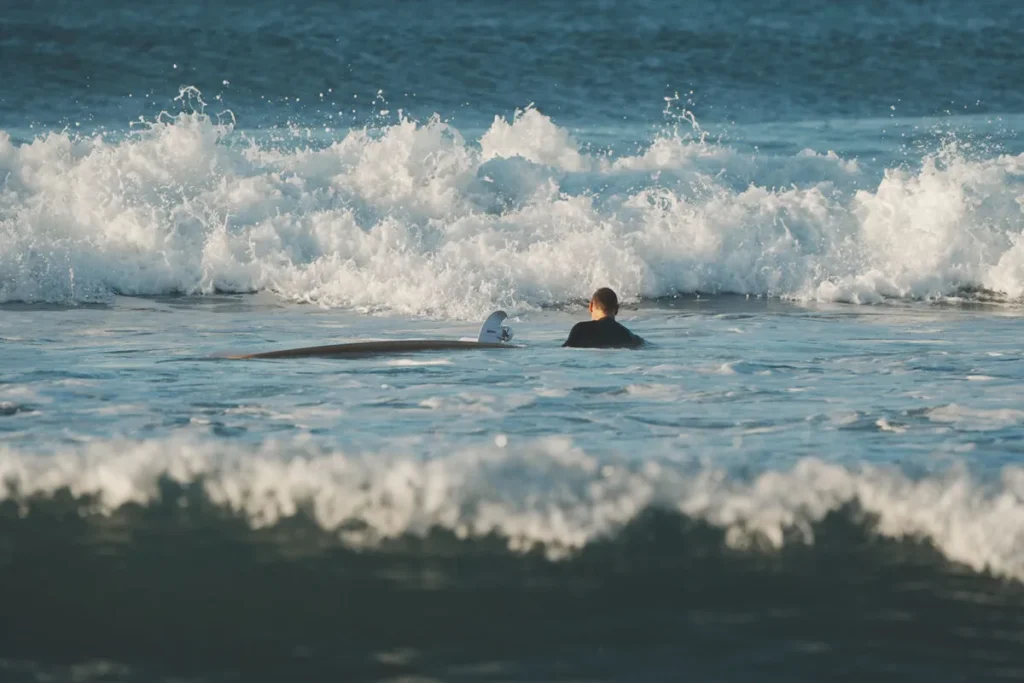
Ya sea que seas un remador experimentado o recién estés comenzando, Boost Fin puede ayudarte a:
- Cubre mayores distancias: navega sin esfuerzo por el agua, explorando más lejos y llegando a lugares más remotos.
- Remar sin esfuerzo: reduce la fatiga y el esfuerzo, especialmente contra corrientes o viento. Disfruta de un paseo más relajado y placentero.
- Conquista las olas: atrapa 3 veces más olas fácilmente y súbelas durante más tiempo con un rápido aumento de potencia.
- Rendimiento en todas las condiciones: el diseño resistente a los golpes soporta condiciones duras, mientras que la batería dura hasta 1,5 horas con una sola carga.
Boost Fin se adapta a todos los niveles de habilidad y ofrece una forma divertida y eficiente de mejorar el paddle surf. Experimente la libertad y la alegría de deslizarse sin esfuerzo por el agua. Con Boost Fin, " cómo ir rápido en una tabla de paddle surf " nunca más será su preocupación.
Si bien los productos Boost Fin ofrecen ventajas interesantes, tenga cuidado con las compras fuera de los canales oficiales. Boost Surfing vende exclusivamente a través de su sitio web y distribuidores autorizados para garantizar la calidad del producto y la validez de la garantía. Los anuncios en plataformas como eBay pueden representar reventas no autorizadas, lo que podría afectar el rendimiento y el soporte. Para garantizar la autenticidad y la tranquilidad, compre directamente a Boost Surfing o a sus socios de confianza. ¡Diviértase con el SUP!


Compartir:
Convertir el paddleboarding en un espectáculo: el viaje de Lee con Boost Fin
Guía de surf de San Clemente: los 10 mejores lugares para practicar surf